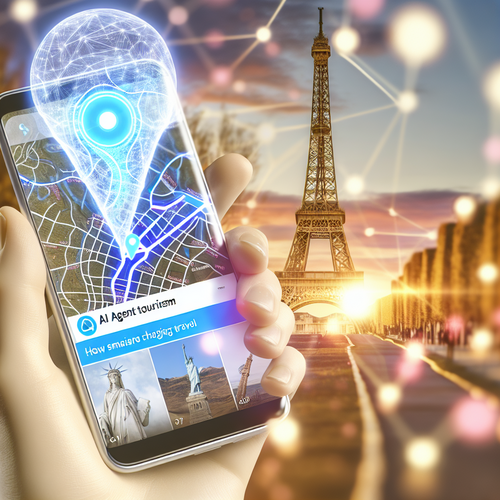Why AI Trip‑Planning Agents Are a Game‑Changer for Travelers 🤖
Traditional travel planning often involves cumbersome manual research, comparing countless websites, reading reviews, and piecing together itineraries without guaranteed coherence or personalization. This process is time-consuming and prone to information overload or outdated data. AI trip-planning agents revolutionize this experience by automating itinerary creation using advanced algorithms that integrate vast datasets, including user preferences, real-time conditions, and local insights.
Unlike traditional methods, AI agents dynamically generate personalized travel plans optimized for individual tastes, budgets, and constraints. They continuously update itineraries based on evolving factors such as weather, transportation schedules, or attraction availability. This agility enables travelers to enjoy seamless, worry-free planning.
Key benefits include significant time savings through automated research and synthesis, enhanced personalization with tailored suggestions, dynamic updates that adapt to changes, and scalability allowing both solo travelers and large tourism businesses to efficiently manage complex itineraries.
Real-world examples demonstrate early return on investment: travelers report reduced planning stress and richer experiences, while tourism businesses leveraging AI agents see improved customer satisfaction and operational efficiencies. The transformative potential of AI in trip planning is prompting stakeholders across tourism to adopt AI-driven solutions for a smarter, more adaptive approach to travel.
How AI Agents Create Personalized, Real‑Time Itineraries ⏱️
AI trip-planning agents operate through a multi-layered process that integrates diverse data inputs and sophisticated modeling to deliver personalized, real-time itineraries.
First, these agents ingest extensive user inputs including profiles (age, travel history), preferences (interests, budget), constraints (time, accessibility), and real-time data streams such as weather forecasts, transportation updates, and venue status (e.g., closures or special events). This comprehensive data foundation ensures planning accuracy and relevance.
Personalization leverages machine learning models that analyze user behavior and preference patterns, enabling the agent to recommend activities, accommodations, and routes tailored uniquely to each traveler. Constraint-aware algorithms adjust suggestions for individual requirements like dietary restrictions or mobility limitations.
AI agents continuously run a real-time adjustment loop, monitoring triggers from integrated APIs—such as flight delays or sudden weather changes—and send instant notifications with alternative plans or adjustments. This dynamic responsiveness maintains itinerary reliability throughout the trip lifecycle.
For example, an AI agent might initially propose a city walking tour based on user interest in culture and leisure. If rain is forecasted, the system automatically revises the plan to include indoor museums and emits alerts to travelers, ensuring a seamless experience.
This end-to-end refinement—combining static preferences and dynamic inputs—enables AI agents to deliver itineraries that evolve in real-time for maximized traveler satisfaction and efficiency.
Choosing an AI Trip‑Planning Platform: Platforms, Pricing & Feature Checklist 💼
Selecting the ideal AI trip-planning platform depends on your use case, budget, and desired features. There are three main platform types: standalone AI-based agents focused solely on itinerary creation; marketplace integrations that combine AI suggestions with direct booking marketplaces; and comprehensive travel-tech suites offering end-to-end solutions including CRM and analytics for businesses.
Pricing models vary widely. Many platforms offer free or freemium tiers with limited features. Subscription plans provide access to advanced personalization and multi-trip management. Some charge per trip or itinerary generated, while others earn commissions from bookings integrated within the platform.
When evaluating a platform, use this feature checklist: robust booking integration (flights, hotels, activities), multi-leg trip support, local recommendations that leverage AI insights, multi-language support for global travelers, accessible APIs for business integration, and strong privacy & data control policies to protect user information.
To assess vendor claims and demos, request trial versions, test the responsiveness and accuracy of the AI planner, compare itinerary quality, and verify how well the platform integrates live data updates. Attention to customer support and platform scalability is also critical for sustained satisfaction.
Careful comparison helps travelers and tourism businesses adopt the most cost-effective and feature-rich AI agent for trip planning needs.
Best Practices to Ensure Accurate, Trustworthy AI Trip Planning ✅
To maximize accuracy and trustworthiness when using AI trip-planning agents, start with precise prompting and feeding the AI reliable constraints such as verified dates, budgets, and user preferences. Clear, structured inputs reduce errors and hallucinations often caused by vague or contradictory requests.
Always verify AI-generated results through cross-checking with trusted sources, live API data (e.g., transport schedules), and cited references when available. Avoid relying solely on AI output without confirmation, especially for critical bookings.
Managing bias and enhancing transparency is essential. Favor platforms that provide explainability features showing why certain recommendations are made and that disclose data provenance to maintain user trust.
Adhere to strict data privacy and consent best practices. Use AI tools that comply with regulations such as GDPR, ensure secure data handling, and allow users control over personal information.
Recognize when human travel advisors should be involved—complex itineraries, niche requests, or detecting inconsistencies benefit from expert human oversight to augment AI insights and mitigate risks.
Following these practices ensures AI-powered travel planning is reliable, privacy-conscious, and user-centric.
Actionable Workflow: Turn an AI Itinerary into a Booked Trip ✈️
Transforming an AI-generated itinerary into a booked trip requires a systematic workflow to minimize risks and maximize value:
- Draft your itinerary in the AI platform, incorporating all preferences and constraints.
- Validate details including dates, transportation timings, accommodation policies, and attraction availability.
- Confirm critical trip components such as visas, vaccinations, cancellation policies, insurance coverage, and any COVID-19 or health requirements before booking.
- Proceed to book using a hybrid approach: leverage automated booking features where trustworthy, complemented by manual verification steps for major legs like flights and accommodations.
- Lock in key trip elements first (e.g., international flights), then book supporting logistics to maintain flexibility.
- After booking, maintain active itinerary updates and contingency planning to adapt to possible changes using integrated notification tools.
A sample 10-step template includes: defining trip goals, gathering inputs, AI itinerary generation, cross-verification, pre-booking checklist completion, incremental booking, payment and confirmation, itinerary consolidation, travel document preparation, and ongoing monitoring.
Following this actionable workflow ensures AI plans translate into smooth, well-organized travel experiences.

